Analyzing Modern Supply Chain Management: Functions and Practices
VerifiedAdded on 2023/06/11
|11
|2732
|101
Report
AI Summary
This report provides a comprehensive analysis of Modern Supply Chain Management (MSCM), highlighting its key functions and practices. It explores the integration of procurement, manufacturing, transportation, logistics, and supply, emphasizing the importance of technology, inventory velocity, supplier performance, and inventory yield. The report discusses the shift from treating supply chain departments as separate entities to a unified approach, with suppliers now considered partners. Effective supply chain management ensures a smooth flow of goods, proper branding, and safe storage. The integration of Human Resources Management (HRM) is also examined, focusing on its role in optimizing organizational operations and employee performance. The report outlines the selection process for modern supply chain managers, including vetting, evaluation, and hiring. It also addresses barriers to supply chain management, such as managing multiple departments and dependence on third parties. The report concludes by recommending the establishment of an interdepartmental supervisor to enhance coordination and effectiveness within the supply chain.
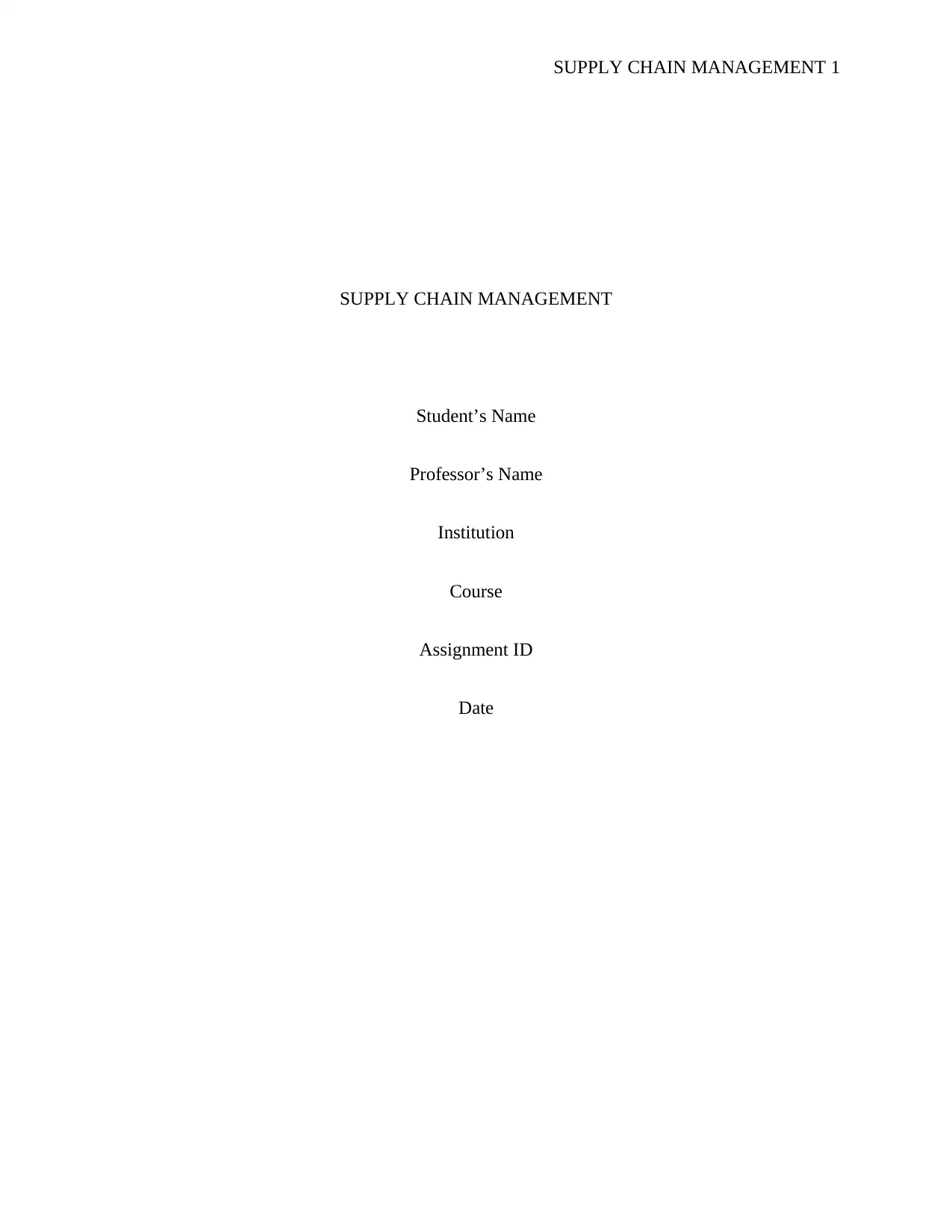
SUPPLY CHAIN MANAGEMENT 1
SUPPLY CHAIN MANAGEMENT
Student’s Name
Professor’s Name
Institution
Course
Assignment ID
Date
SUPPLY CHAIN MANAGEMENT
Student’s Name
Professor’s Name
Institution
Course
Assignment ID
Date
Paraphrase This Document
Need a fresh take? Get an instant paraphrase of this document with our AI Paraphraser
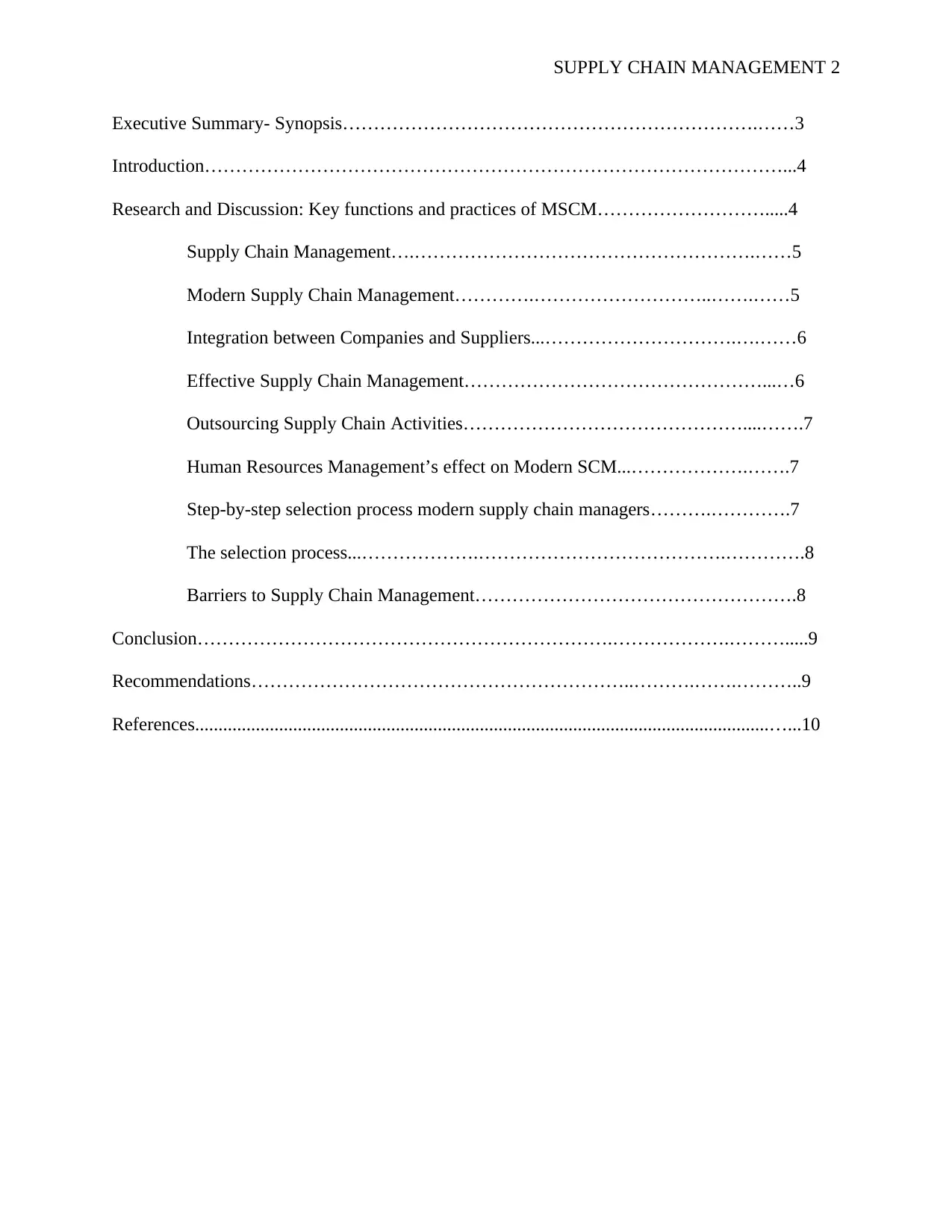
SUPPLY CHAIN MANAGEMENT 2
Executive Summary- Synopsis………………………………………………………….……3
Introduction…………………………………………………………………………………...4
Research and Discussion: Key functions and practices of MSCM……………………….....4
Supply Chain Management….……………………………………………….……5
Modern Supply Chain Management………….………………………..…….……5
Integration between Companies and Suppliers...………………………….….……6
Effective Supply Chain Management…………………………………………...…6
Outsourcing Supply Chain Activities………………………………………....…….7
Human Resources Management’s effect on Modern SCM...……………….…….7
Step-by-step selection process modern supply chain managers……….………….7
The selection process...……………….………………………………….………….8
Barriers to Supply Chain Management…………………………………………….8
Conclusion………………………………………………………….……………….……….....9
Recommendations……………………………………………………..……….…….………..9
References...........................................................................................................................…...10
Executive Summary- Synopsis………………………………………………………….……3
Introduction…………………………………………………………………………………...4
Research and Discussion: Key functions and practices of MSCM……………………….....4
Supply Chain Management….……………………………………………….……5
Modern Supply Chain Management………….………………………..…….……5
Integration between Companies and Suppliers...………………………….….……6
Effective Supply Chain Management…………………………………………...…6
Outsourcing Supply Chain Activities………………………………………....…….7
Human Resources Management’s effect on Modern SCM...……………….…….7
Step-by-step selection process modern supply chain managers……….………….7
The selection process...……………….………………………………….………….8
Barriers to Supply Chain Management…………………………………………….8
Conclusion………………………………………………………….……………….……….....9
Recommendations……………………………………………………..……….…….………..9
References...........................................................................................................................…...10
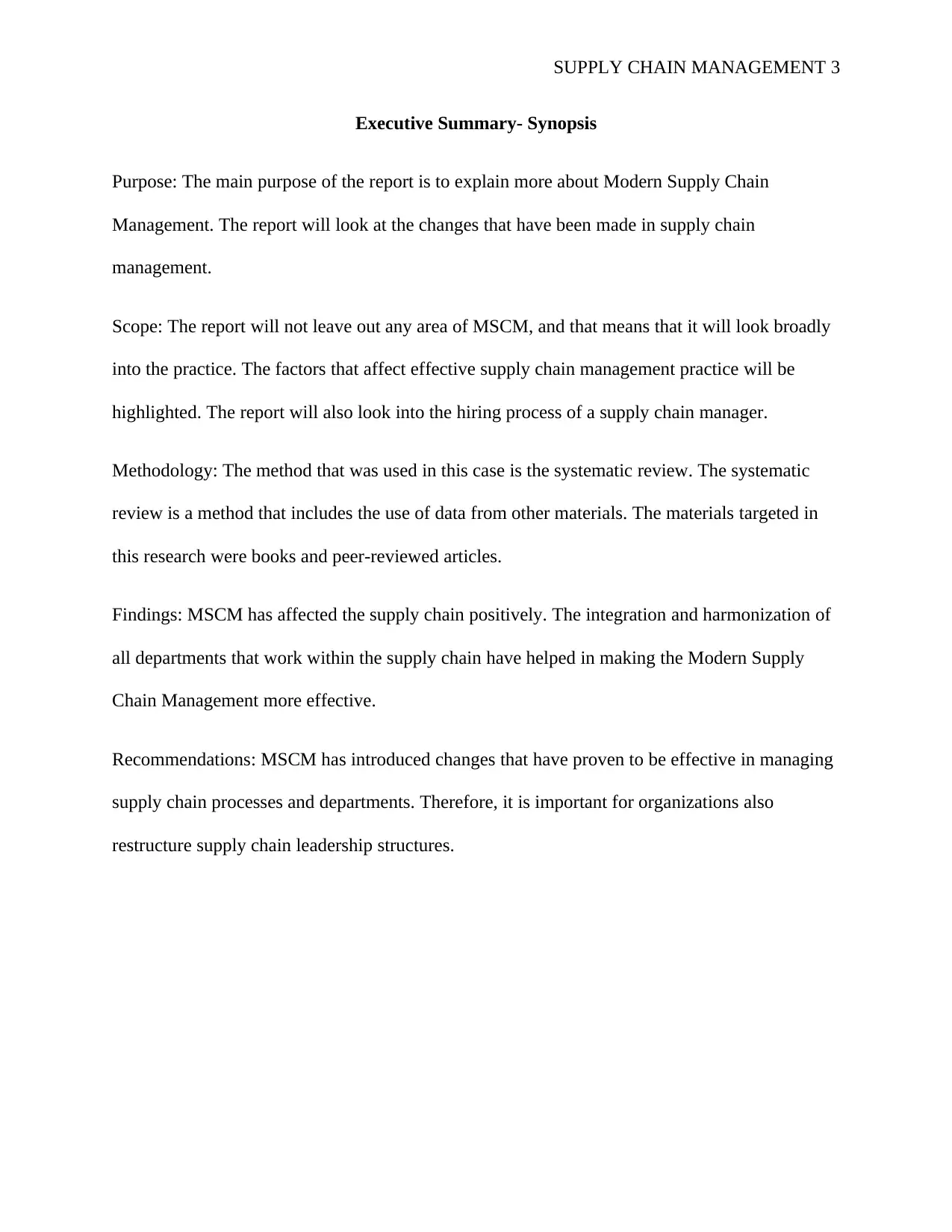
SUPPLY CHAIN MANAGEMENT 3
Executive Summary- Synopsis
Purpose: The main purpose of the report is to explain more about Modern Supply Chain
Management. The report will look at the changes that have been made in supply chain
management.
Scope: The report will not leave out any area of MSCM, and that means that it will look broadly
into the practice. The factors that affect effective supply chain management practice will be
highlighted. The report will also look into the hiring process of a supply chain manager.
Methodology: The method that was used in this case is the systematic review. The systematic
review is a method that includes the use of data from other materials. The materials targeted in
this research were books and peer-reviewed articles.
Findings: MSCM has affected the supply chain positively. The integration and harmonization of
all departments that work within the supply chain have helped in making the Modern Supply
Chain Management more effective.
Recommendations: MSCM has introduced changes that have proven to be effective in managing
supply chain processes and departments. Therefore, it is important for organizations also
restructure supply chain leadership structures.
Executive Summary- Synopsis
Purpose: The main purpose of the report is to explain more about Modern Supply Chain
Management. The report will look at the changes that have been made in supply chain
management.
Scope: The report will not leave out any area of MSCM, and that means that it will look broadly
into the practice. The factors that affect effective supply chain management practice will be
highlighted. The report will also look into the hiring process of a supply chain manager.
Methodology: The method that was used in this case is the systematic review. The systematic
review is a method that includes the use of data from other materials. The materials targeted in
this research were books and peer-reviewed articles.
Findings: MSCM has affected the supply chain positively. The integration and harmonization of
all departments that work within the supply chain have helped in making the Modern Supply
Chain Management more effective.
Recommendations: MSCM has introduced changes that have proven to be effective in managing
supply chain processes and departments. Therefore, it is important for organizations also
restructure supply chain leadership structures.
⊘ This is a preview!⊘
Do you want full access?
Subscribe today to unlock all pages.

Trusted by 1+ million students worldwide
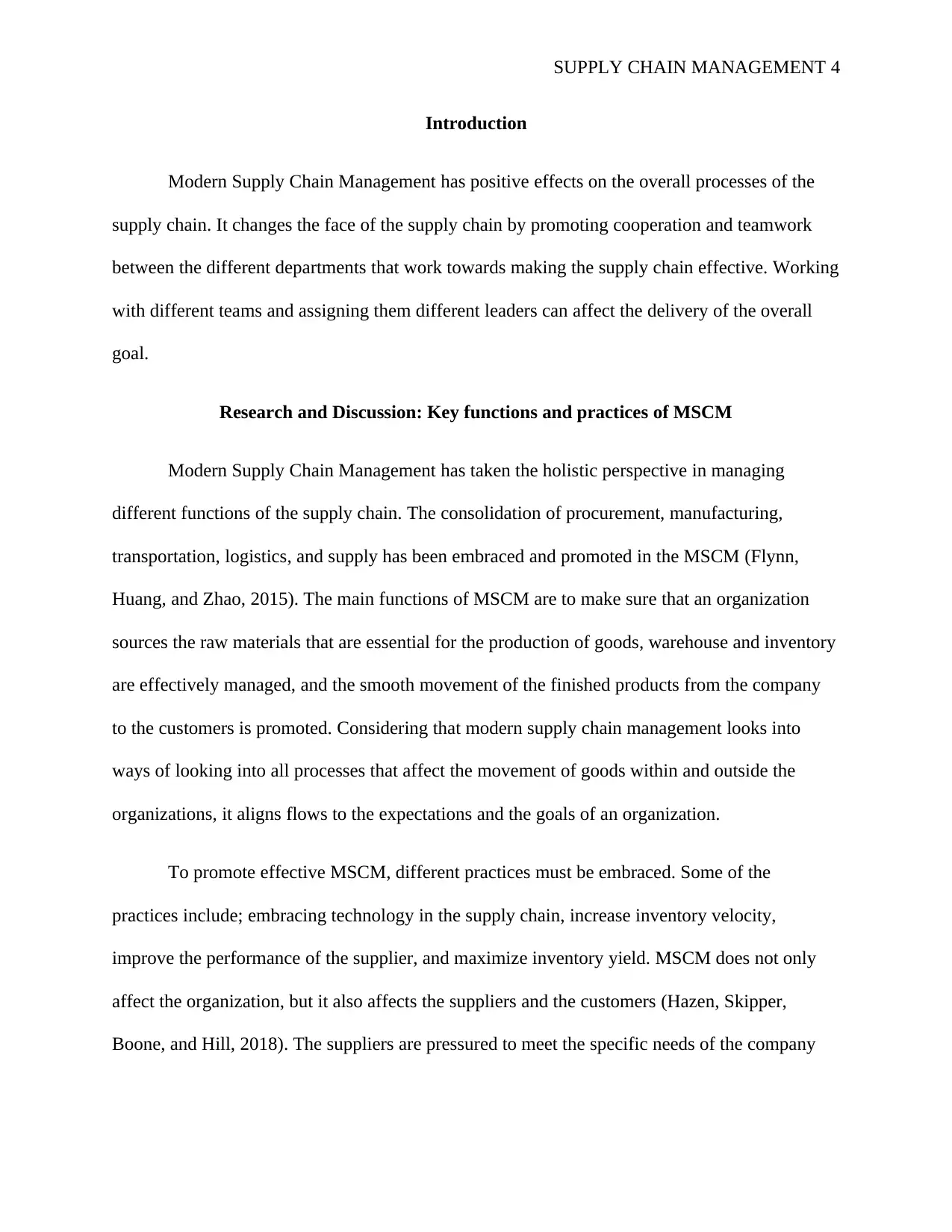
SUPPLY CHAIN MANAGEMENT 4
Introduction
Modern Supply Chain Management has positive effects on the overall processes of the
supply chain. It changes the face of the supply chain by promoting cooperation and teamwork
between the different departments that work towards making the supply chain effective. Working
with different teams and assigning them different leaders can affect the delivery of the overall
goal.
Research and Discussion: Key functions and practices of MSCM
Modern Supply Chain Management has taken the holistic perspective in managing
different functions of the supply chain. The consolidation of procurement, manufacturing,
transportation, logistics, and supply has been embraced and promoted in the MSCM (Flynn,
Huang, and Zhao, 2015). The main functions of MSCM are to make sure that an organization
sources the raw materials that are essential for the production of goods, warehouse and inventory
are effectively managed, and the smooth movement of the finished products from the company
to the customers is promoted. Considering that modern supply chain management looks into
ways of looking into all processes that affect the movement of goods within and outside the
organizations, it aligns flows to the expectations and the goals of an organization.
To promote effective MSCM, different practices must be embraced. Some of the
practices include; embracing technology in the supply chain, increase inventory velocity,
improve the performance of the supplier, and maximize inventory yield. MSCM does not only
affect the organization, but it also affects the suppliers and the customers (Hazen, Skipper,
Boone, and Hill, 2018). The suppliers are pressured to meet the specific needs of the company
Introduction
Modern Supply Chain Management has positive effects on the overall processes of the
supply chain. It changes the face of the supply chain by promoting cooperation and teamwork
between the different departments that work towards making the supply chain effective. Working
with different teams and assigning them different leaders can affect the delivery of the overall
goal.
Research and Discussion: Key functions and practices of MSCM
Modern Supply Chain Management has taken the holistic perspective in managing
different functions of the supply chain. The consolidation of procurement, manufacturing,
transportation, logistics, and supply has been embraced and promoted in the MSCM (Flynn,
Huang, and Zhao, 2015). The main functions of MSCM are to make sure that an organization
sources the raw materials that are essential for the production of goods, warehouse and inventory
are effectively managed, and the smooth movement of the finished products from the company
to the customers is promoted. Considering that modern supply chain management looks into
ways of looking into all processes that affect the movement of goods within and outside the
organizations, it aligns flows to the expectations and the goals of an organization.
To promote effective MSCM, different practices must be embraced. Some of the
practices include; embracing technology in the supply chain, increase inventory velocity,
improve the performance of the supplier, and maximize inventory yield. MSCM does not only
affect the organization, but it also affects the suppliers and the customers (Hazen, Skipper,
Boone, and Hill, 2018). The suppliers are pressured to meet the specific needs of the company
Paraphrase This Document
Need a fresh take? Get an instant paraphrase of this document with our AI Paraphraser
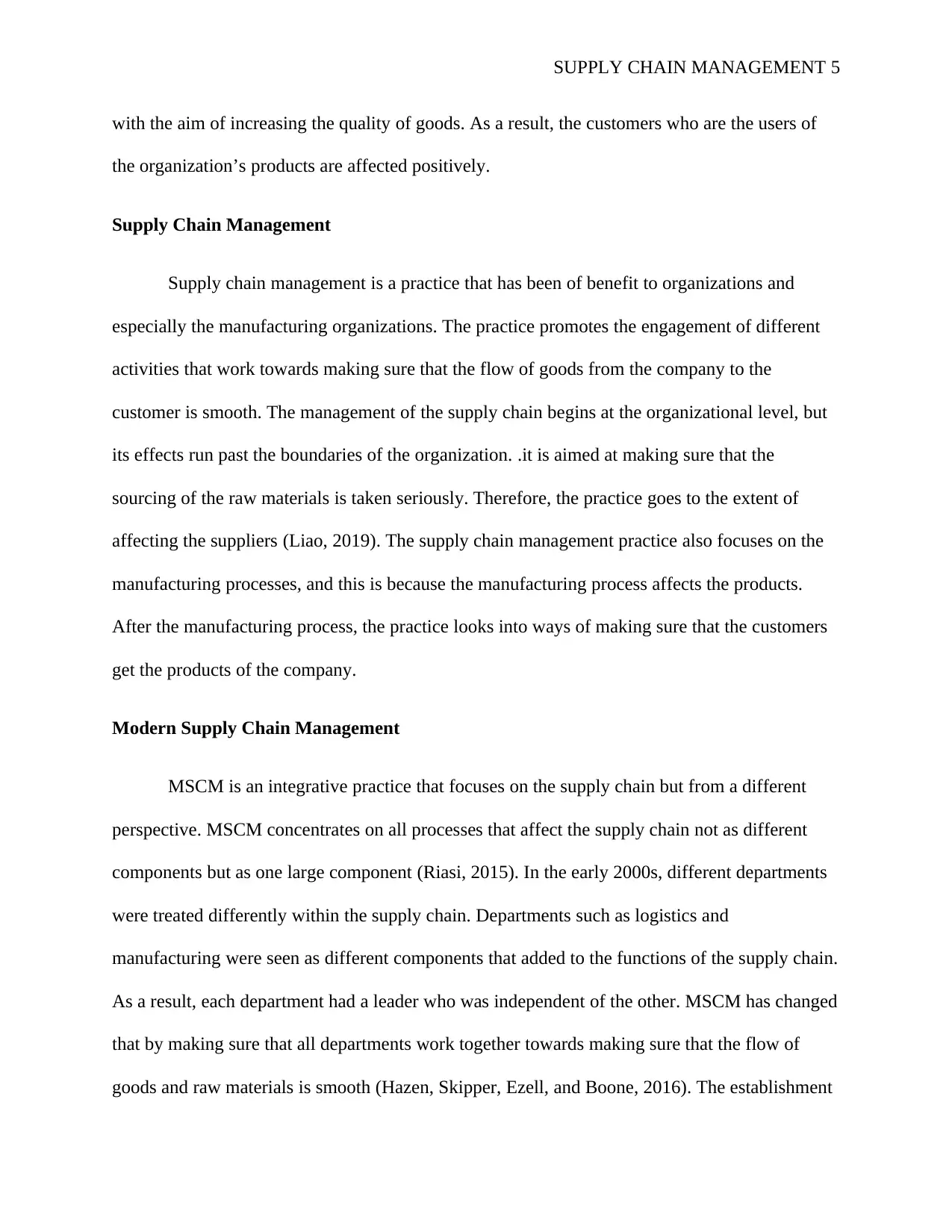
SUPPLY CHAIN MANAGEMENT 5
with the aim of increasing the quality of goods. As a result, the customers who are the users of
the organization’s products are affected positively.
Supply Chain Management
Supply chain management is a practice that has been of benefit to organizations and
especially the manufacturing organizations. The practice promotes the engagement of different
activities that work towards making sure that the flow of goods from the company to the
customer is smooth. The management of the supply chain begins at the organizational level, but
its effects run past the boundaries of the organization. .it is aimed at making sure that the
sourcing of the raw materials is taken seriously. Therefore, the practice goes to the extent of
affecting the suppliers (Liao, 2019). The supply chain management practice also focuses on the
manufacturing processes, and this is because the manufacturing process affects the products.
After the manufacturing process, the practice looks into ways of making sure that the customers
get the products of the company.
Modern Supply Chain Management
MSCM is an integrative practice that focuses on the supply chain but from a different
perspective. MSCM concentrates on all processes that affect the supply chain not as different
components but as one large component (Riasi, 2015). In the early 2000s, different departments
were treated differently within the supply chain. Departments such as logistics and
manufacturing were seen as different components that added to the functions of the supply chain.
As a result, each department had a leader who was independent of the other. MSCM has changed
that by making sure that all departments work together towards making sure that the flow of
goods and raw materials is smooth (Hazen, Skipper, Ezell, and Boone, 2016). The establishment
with the aim of increasing the quality of goods. As a result, the customers who are the users of
the organization’s products are affected positively.
Supply Chain Management
Supply chain management is a practice that has been of benefit to organizations and
especially the manufacturing organizations. The practice promotes the engagement of different
activities that work towards making sure that the flow of goods from the company to the
customer is smooth. The management of the supply chain begins at the organizational level, but
its effects run past the boundaries of the organization. .it is aimed at making sure that the
sourcing of the raw materials is taken seriously. Therefore, the practice goes to the extent of
affecting the suppliers (Liao, 2019). The supply chain management practice also focuses on the
manufacturing processes, and this is because the manufacturing process affects the products.
After the manufacturing process, the practice looks into ways of making sure that the customers
get the products of the company.
Modern Supply Chain Management
MSCM is an integrative practice that focuses on the supply chain but from a different
perspective. MSCM concentrates on all processes that affect the supply chain not as different
components but as one large component (Riasi, 2015). In the early 2000s, different departments
were treated differently within the supply chain. Departments such as logistics and
manufacturing were seen as different components that added to the functions of the supply chain.
As a result, each department had a leader who was independent of the other. MSCM has changed
that by making sure that all departments work together towards making sure that the flow of
goods and raw materials is smooth (Hazen, Skipper, Ezell, and Boone, 2016). The establishment
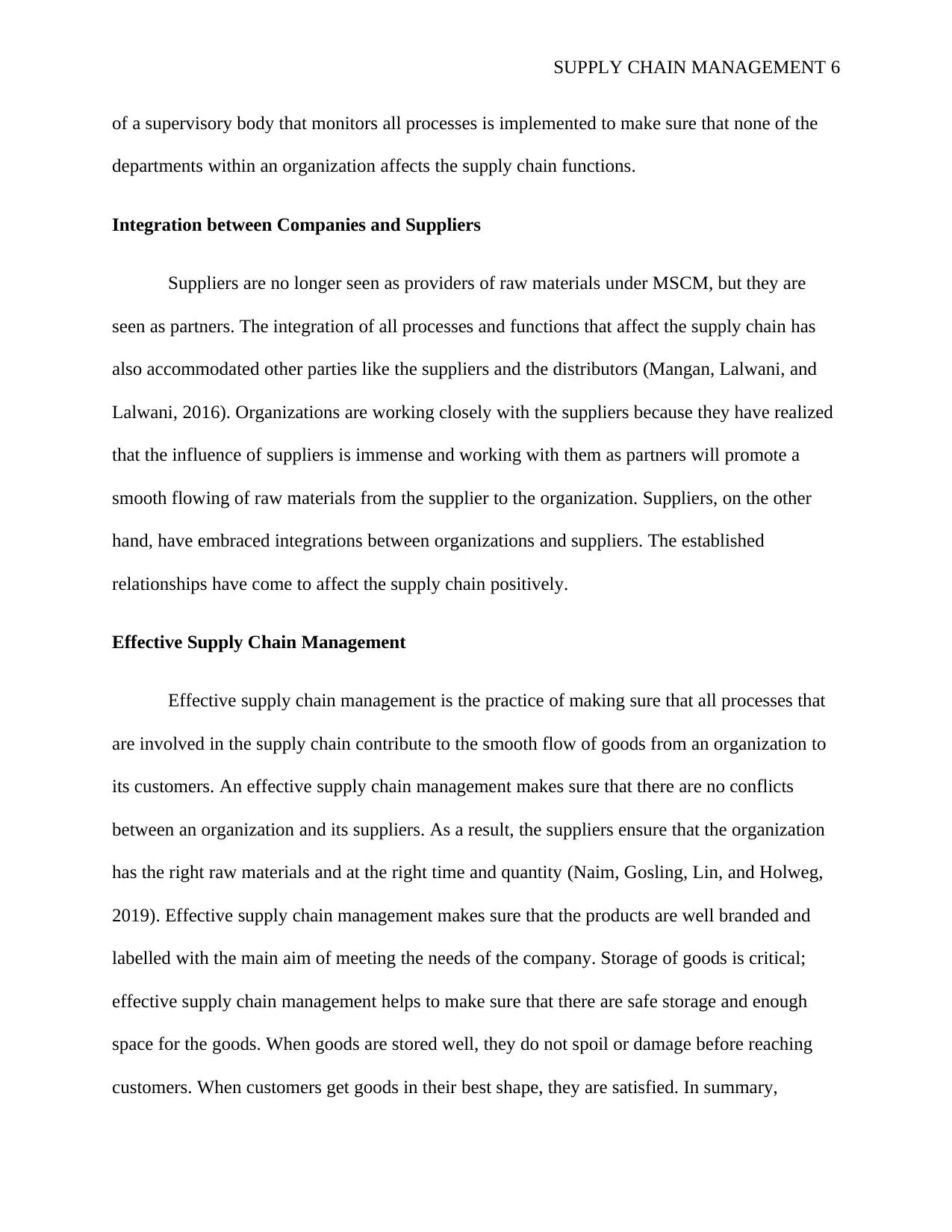
SUPPLY CHAIN MANAGEMENT 6
of a supervisory body that monitors all processes is implemented to make sure that none of the
departments within an organization affects the supply chain functions.
Integration between Companies and Suppliers
Suppliers are no longer seen as providers of raw materials under MSCM, but they are
seen as partners. The integration of all processes and functions that affect the supply chain has
also accommodated other parties like the suppliers and the distributors (Mangan, Lalwani, and
Lalwani, 2016). Organizations are working closely with the suppliers because they have realized
that the influence of suppliers is immense and working with them as partners will promote a
smooth flowing of raw materials from the supplier to the organization. Suppliers, on the other
hand, have embraced integrations between organizations and suppliers. The established
relationships have come to affect the supply chain positively.
Effective Supply Chain Management
Effective supply chain management is the practice of making sure that all processes that
are involved in the supply chain contribute to the smooth flow of goods from an organization to
its customers. An effective supply chain management makes sure that there are no conflicts
between an organization and its suppliers. As a result, the suppliers ensure that the organization
has the right raw materials and at the right time and quantity (Naim, Gosling, Lin, and Holweg,
2019). Effective supply chain management makes sure that the products are well branded and
labelled with the main aim of meeting the needs of the company. Storage of goods is critical;
effective supply chain management helps to make sure that there are safe storage and enough
space for the goods. When goods are stored well, they do not spoil or damage before reaching
customers. When customers get goods in their best shape, they are satisfied. In summary,
of a supervisory body that monitors all processes is implemented to make sure that none of the
departments within an organization affects the supply chain functions.
Integration between Companies and Suppliers
Suppliers are no longer seen as providers of raw materials under MSCM, but they are
seen as partners. The integration of all processes and functions that affect the supply chain has
also accommodated other parties like the suppliers and the distributors (Mangan, Lalwani, and
Lalwani, 2016). Organizations are working closely with the suppliers because they have realized
that the influence of suppliers is immense and working with them as partners will promote a
smooth flowing of raw materials from the supplier to the organization. Suppliers, on the other
hand, have embraced integrations between organizations and suppliers. The established
relationships have come to affect the supply chain positively.
Effective Supply Chain Management
Effective supply chain management is the practice of making sure that all processes that
are involved in the supply chain contribute to the smooth flow of goods from an organization to
its customers. An effective supply chain management makes sure that there are no conflicts
between an organization and its suppliers. As a result, the suppliers ensure that the organization
has the right raw materials and at the right time and quantity (Naim, Gosling, Lin, and Holweg,
2019). Effective supply chain management makes sure that the products are well branded and
labelled with the main aim of meeting the needs of the company. Storage of goods is critical;
effective supply chain management helps to make sure that there are safe storage and enough
space for the goods. When goods are stored well, they do not spoil or damage before reaching
customers. When customers get goods in their best shape, they are satisfied. In summary,
⊘ This is a preview!⊘
Do you want full access?
Subscribe today to unlock all pages.

Trusted by 1+ million students worldwide
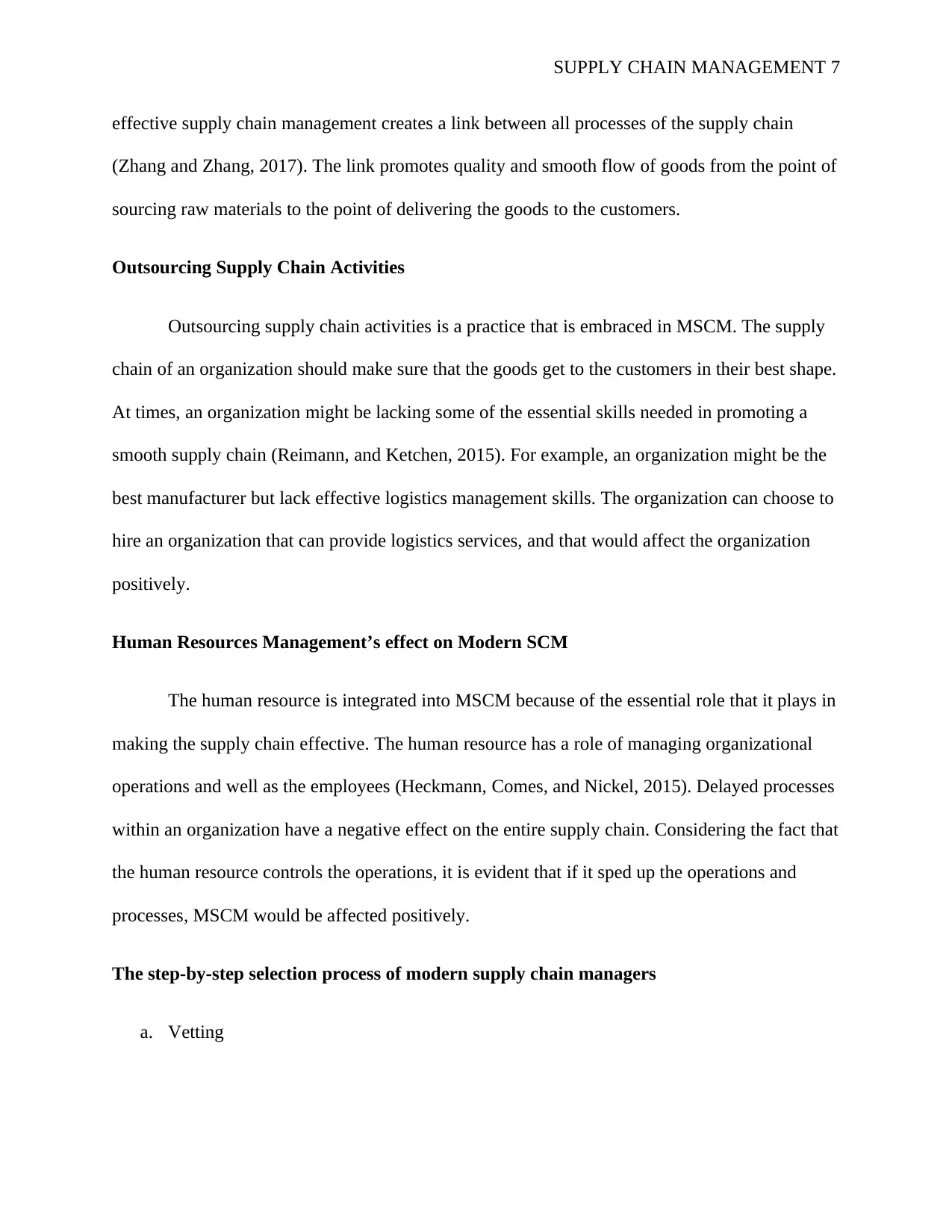
SUPPLY CHAIN MANAGEMENT 7
effective supply chain management creates a link between all processes of the supply chain
(Zhang and Zhang, 2017). The link promotes quality and smooth flow of goods from the point of
sourcing raw materials to the point of delivering the goods to the customers.
Outsourcing Supply Chain Activities
Outsourcing supply chain activities is a practice that is embraced in MSCM. The supply
chain of an organization should make sure that the goods get to the customers in their best shape.
At times, an organization might be lacking some of the essential skills needed in promoting a
smooth supply chain (Reimann, and Ketchen, 2015). For example, an organization might be the
best manufacturer but lack effective logistics management skills. The organization can choose to
hire an organization that can provide logistics services, and that would affect the organization
positively.
Human Resources Management’s effect on Modern SCM
The human resource is integrated into MSCM because of the essential role that it plays in
making the supply chain effective. The human resource has a role of managing organizational
operations and well as the employees (Heckmann, Comes, and Nickel, 2015). Delayed processes
within an organization have a negative effect on the entire supply chain. Considering the fact that
the human resource controls the operations, it is evident that if it sped up the operations and
processes, MSCM would be affected positively.
The step-by-step selection process of modern supply chain managers
a. Vetting
effective supply chain management creates a link between all processes of the supply chain
(Zhang and Zhang, 2017). The link promotes quality and smooth flow of goods from the point of
sourcing raw materials to the point of delivering the goods to the customers.
Outsourcing Supply Chain Activities
Outsourcing supply chain activities is a practice that is embraced in MSCM. The supply
chain of an organization should make sure that the goods get to the customers in their best shape.
At times, an organization might be lacking some of the essential skills needed in promoting a
smooth supply chain (Reimann, and Ketchen, 2015). For example, an organization might be the
best manufacturer but lack effective logistics management skills. The organization can choose to
hire an organization that can provide logistics services, and that would affect the organization
positively.
Human Resources Management’s effect on Modern SCM
The human resource is integrated into MSCM because of the essential role that it plays in
making the supply chain effective. The human resource has a role of managing organizational
operations and well as the employees (Heckmann, Comes, and Nickel, 2015). Delayed processes
within an organization have a negative effect on the entire supply chain. Considering the fact that
the human resource controls the operations, it is evident that if it sped up the operations and
processes, MSCM would be affected positively.
The step-by-step selection process of modern supply chain managers
a. Vetting
Paraphrase This Document
Need a fresh take? Get an instant paraphrase of this document with our AI Paraphraser
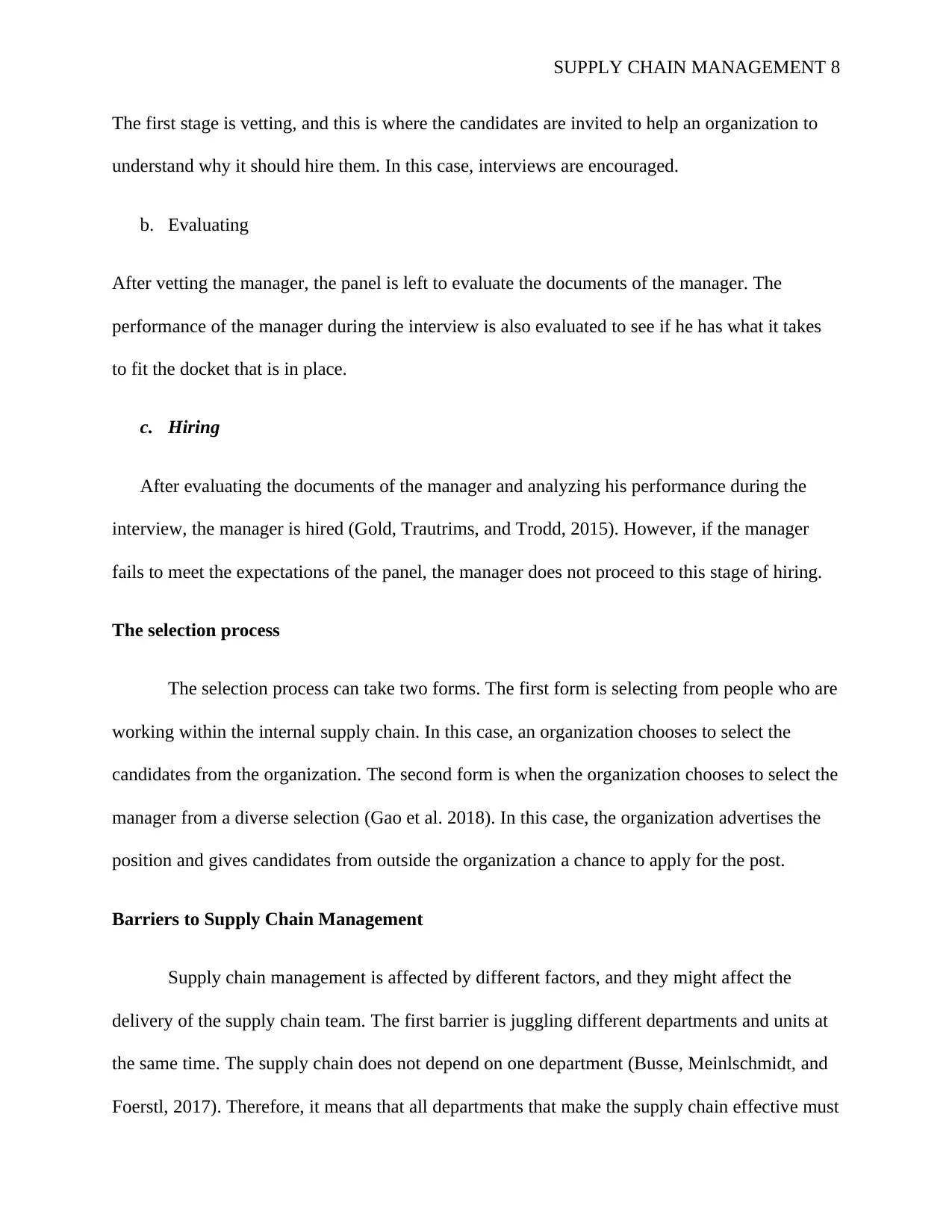
SUPPLY CHAIN MANAGEMENT 8
The first stage is vetting, and this is where the candidates are invited to help an organization to
understand why it should hire them. In this case, interviews are encouraged.
b. Evaluating
After vetting the manager, the panel is left to evaluate the documents of the manager. The
performance of the manager during the interview is also evaluated to see if he has what it takes
to fit the docket that is in place.
c. Hiring
After evaluating the documents of the manager and analyzing his performance during the
interview, the manager is hired (Gold, Trautrims, and Trodd, 2015). However, if the manager
fails to meet the expectations of the panel, the manager does not proceed to this stage of hiring.
The selection process
The selection process can take two forms. The first form is selecting from people who are
working within the internal supply chain. In this case, an organization chooses to select the
candidates from the organization. The second form is when the organization chooses to select the
manager from a diverse selection (Gao et al. 2018). In this case, the organization advertises the
position and gives candidates from outside the organization a chance to apply for the post.
Barriers to Supply Chain Management
Supply chain management is affected by different factors, and they might affect the
delivery of the supply chain team. The first barrier is juggling different departments and units at
the same time. The supply chain does not depend on one department (Busse, Meinlschmidt, and
Foerstl, 2017). Therefore, it means that all departments that make the supply chain effective must
The first stage is vetting, and this is where the candidates are invited to help an organization to
understand why it should hire them. In this case, interviews are encouraged.
b. Evaluating
After vetting the manager, the panel is left to evaluate the documents of the manager. The
performance of the manager during the interview is also evaluated to see if he has what it takes
to fit the docket that is in place.
c. Hiring
After evaluating the documents of the manager and analyzing his performance during the
interview, the manager is hired (Gold, Trautrims, and Trodd, 2015). However, if the manager
fails to meet the expectations of the panel, the manager does not proceed to this stage of hiring.
The selection process
The selection process can take two forms. The first form is selecting from people who are
working within the internal supply chain. In this case, an organization chooses to select the
candidates from the organization. The second form is when the organization chooses to select the
manager from a diverse selection (Gao et al. 2018). In this case, the organization advertises the
position and gives candidates from outside the organization a chance to apply for the post.
Barriers to Supply Chain Management
Supply chain management is affected by different factors, and they might affect the
delivery of the supply chain team. The first barrier is juggling different departments and units at
the same time. The supply chain does not depend on one department (Busse, Meinlschmidt, and
Foerstl, 2017). Therefore, it means that all departments that make the supply chain effective must
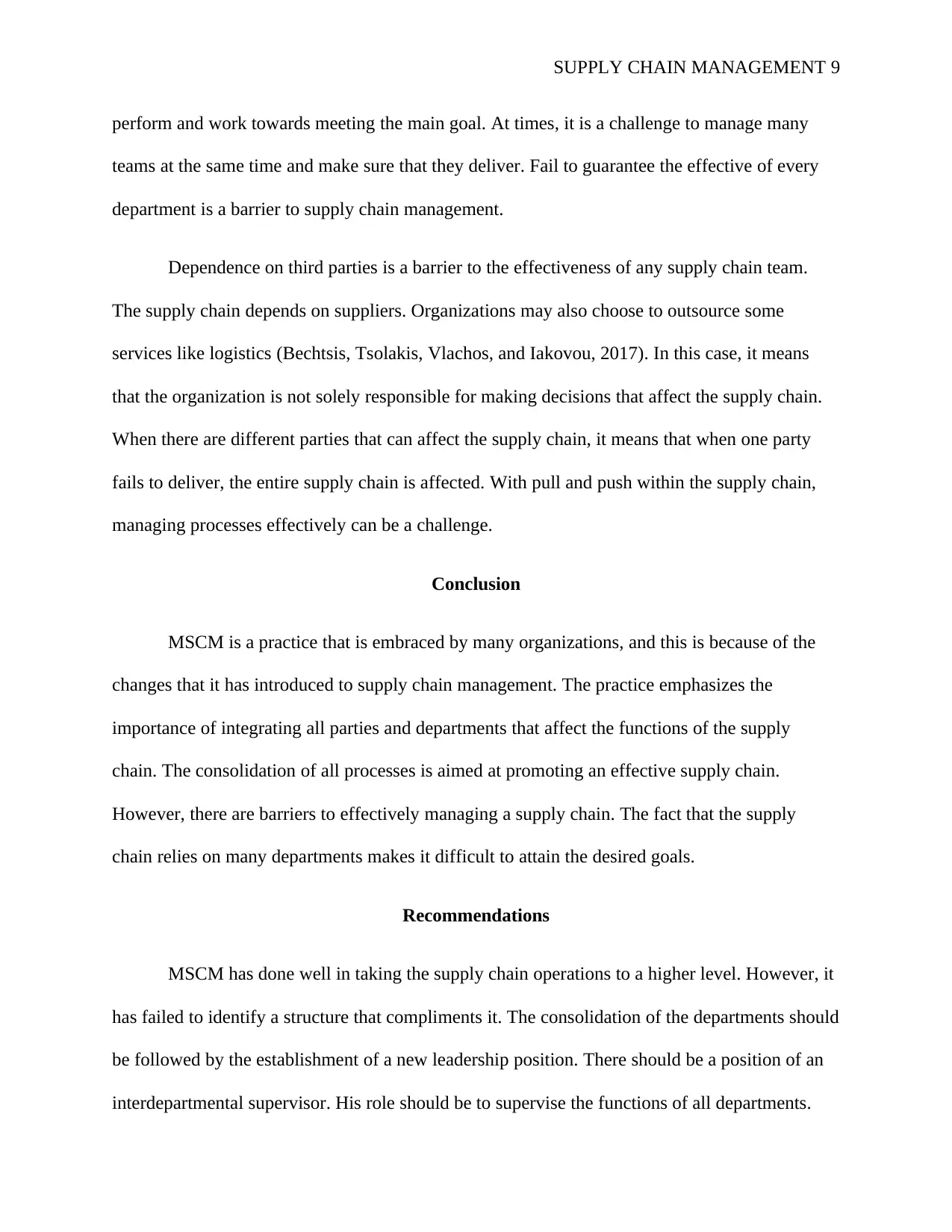
SUPPLY CHAIN MANAGEMENT 9
perform and work towards meeting the main goal. At times, it is a challenge to manage many
teams at the same time and make sure that they deliver. Fail to guarantee the effective of every
department is a barrier to supply chain management.
Dependence on third parties is a barrier to the effectiveness of any supply chain team.
The supply chain depends on suppliers. Organizations may also choose to outsource some
services like logistics (Bechtsis, Tsolakis, Vlachos, and Iakovou, 2017). In this case, it means
that the organization is not solely responsible for making decisions that affect the supply chain.
When there are different parties that can affect the supply chain, it means that when one party
fails to deliver, the entire supply chain is affected. With pull and push within the supply chain,
managing processes effectively can be a challenge.
Conclusion
MSCM is a practice that is embraced by many organizations, and this is because of the
changes that it has introduced to supply chain management. The practice emphasizes the
importance of integrating all parties and departments that affect the functions of the supply
chain. The consolidation of all processes is aimed at promoting an effective supply chain.
However, there are barriers to effectively managing a supply chain. The fact that the supply
chain relies on many departments makes it difficult to attain the desired goals.
Recommendations
MSCM has done well in taking the supply chain operations to a higher level. However, it
has failed to identify a structure that compliments it. The consolidation of the departments should
be followed by the establishment of a new leadership position. There should be a position of an
interdepartmental supervisor. His role should be to supervise the functions of all departments.
perform and work towards meeting the main goal. At times, it is a challenge to manage many
teams at the same time and make sure that they deliver. Fail to guarantee the effective of every
department is a barrier to supply chain management.
Dependence on third parties is a barrier to the effectiveness of any supply chain team.
The supply chain depends on suppliers. Organizations may also choose to outsource some
services like logistics (Bechtsis, Tsolakis, Vlachos, and Iakovou, 2017). In this case, it means
that the organization is not solely responsible for making decisions that affect the supply chain.
When there are different parties that can affect the supply chain, it means that when one party
fails to deliver, the entire supply chain is affected. With pull and push within the supply chain,
managing processes effectively can be a challenge.
Conclusion
MSCM is a practice that is embraced by many organizations, and this is because of the
changes that it has introduced to supply chain management. The practice emphasizes the
importance of integrating all parties and departments that affect the functions of the supply
chain. The consolidation of all processes is aimed at promoting an effective supply chain.
However, there are barriers to effectively managing a supply chain. The fact that the supply
chain relies on many departments makes it difficult to attain the desired goals.
Recommendations
MSCM has done well in taking the supply chain operations to a higher level. However, it
has failed to identify a structure that compliments it. The consolidation of the departments should
be followed by the establishment of a new leadership position. There should be a position of an
interdepartmental supervisor. His role should be to supervise the functions of all departments.
⊘ This is a preview!⊘
Do you want full access?
Subscribe today to unlock all pages.

Trusted by 1+ million students worldwide
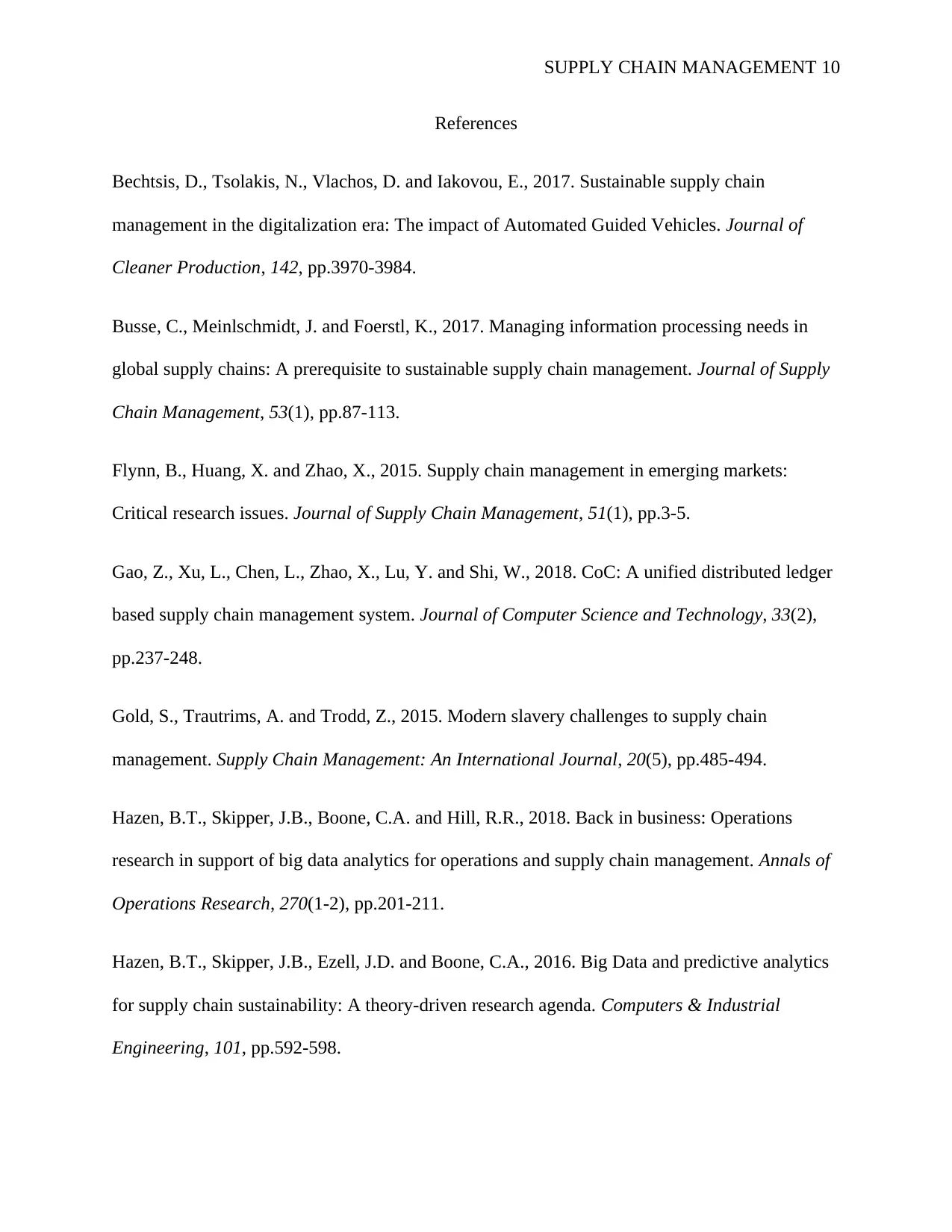
SUPPLY CHAIN MANAGEMENT 10
References
Bechtsis, D., Tsolakis, N., Vlachos, D. and Iakovou, E., 2017. Sustainable supply chain
management in the digitalization era: The impact of Automated Guided Vehicles. Journal of
Cleaner Production, 142, pp.3970-3984.
Busse, C., Meinlschmidt, J. and Foerstl, K., 2017. Managing information processing needs in
global supply chains: A prerequisite to sustainable supply chain management. Journal of Supply
Chain Management, 53(1), pp.87-113.
Flynn, B., Huang, X. and Zhao, X., 2015. Supply chain management in emerging markets:
Critical research issues. Journal of Supply Chain Management, 51(1), pp.3-5.
Gao, Z., Xu, L., Chen, L., Zhao, X., Lu, Y. and Shi, W., 2018. CoC: A unified distributed ledger
based supply chain management system. Journal of Computer Science and Technology, 33(2),
pp.237-248.
Gold, S., Trautrims, A. and Trodd, Z., 2015. Modern slavery challenges to supply chain
management. Supply Chain Management: An International Journal, 20(5), pp.485-494.
Hazen, B.T., Skipper, J.B., Boone, C.A. and Hill, R.R., 2018. Back in business: Operations
research in support of big data analytics for operations and supply chain management. Annals of
Operations Research, 270(1-2), pp.201-211.
Hazen, B.T., Skipper, J.B., Ezell, J.D. and Boone, C.A., 2016. Big Data and predictive analytics
for supply chain sustainability: A theory-driven research agenda. Computers & Industrial
Engineering, 101, pp.592-598.
References
Bechtsis, D., Tsolakis, N., Vlachos, D. and Iakovou, E., 2017. Sustainable supply chain
management in the digitalization era: The impact of Automated Guided Vehicles. Journal of
Cleaner Production, 142, pp.3970-3984.
Busse, C., Meinlschmidt, J. and Foerstl, K., 2017. Managing information processing needs in
global supply chains: A prerequisite to sustainable supply chain management. Journal of Supply
Chain Management, 53(1), pp.87-113.
Flynn, B., Huang, X. and Zhao, X., 2015. Supply chain management in emerging markets:
Critical research issues. Journal of Supply Chain Management, 51(1), pp.3-5.
Gao, Z., Xu, L., Chen, L., Zhao, X., Lu, Y. and Shi, W., 2018. CoC: A unified distributed ledger
based supply chain management system. Journal of Computer Science and Technology, 33(2),
pp.237-248.
Gold, S., Trautrims, A. and Trodd, Z., 2015. Modern slavery challenges to supply chain
management. Supply Chain Management: An International Journal, 20(5), pp.485-494.
Hazen, B.T., Skipper, J.B., Boone, C.A. and Hill, R.R., 2018. Back in business: Operations
research in support of big data analytics for operations and supply chain management. Annals of
Operations Research, 270(1-2), pp.201-211.
Hazen, B.T., Skipper, J.B., Ezell, J.D. and Boone, C.A., 2016. Big Data and predictive analytics
for supply chain sustainability: A theory-driven research agenda. Computers & Industrial
Engineering, 101, pp.592-598.
Paraphrase This Document
Need a fresh take? Get an instant paraphrase of this document with our AI Paraphraser
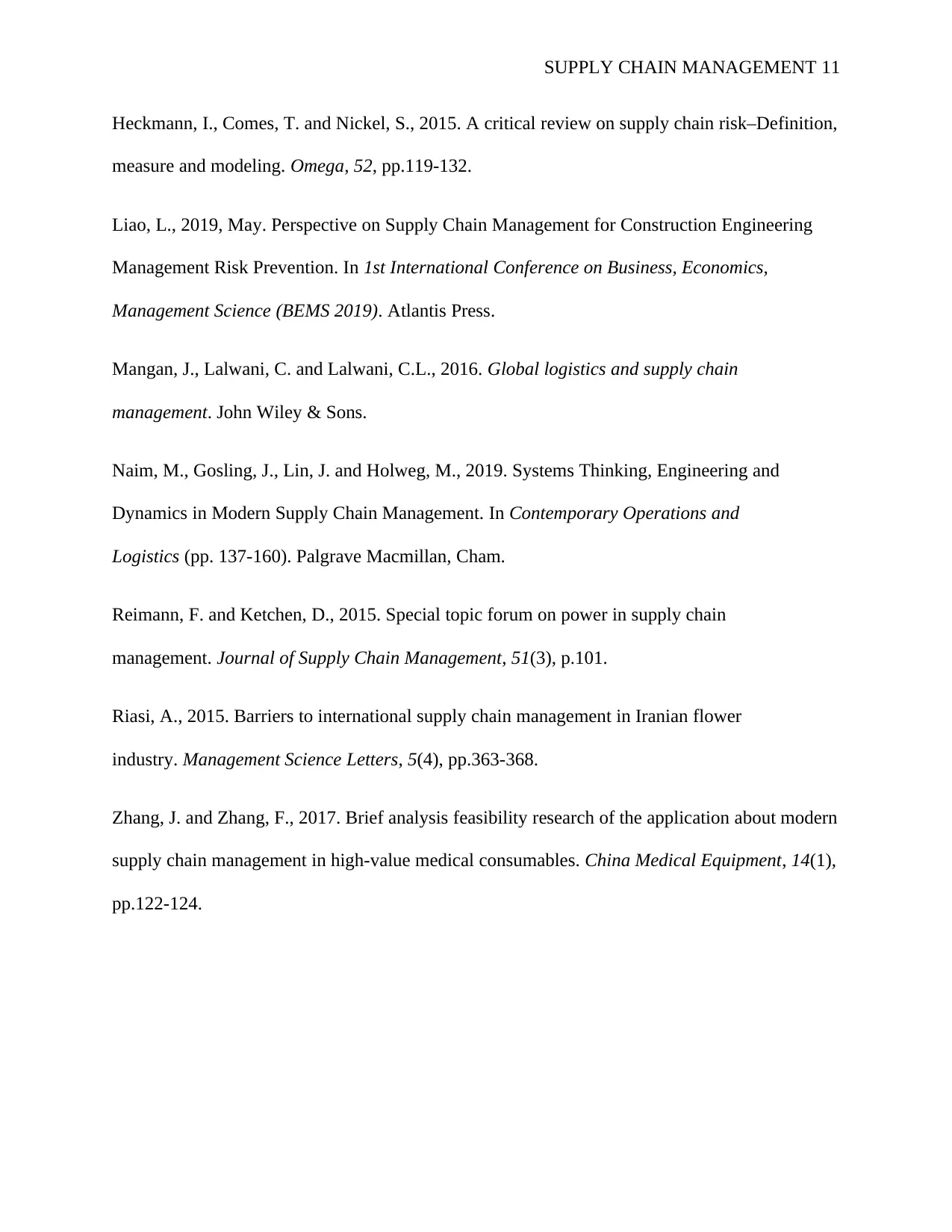
SUPPLY CHAIN MANAGEMENT 11
Heckmann, I., Comes, T. and Nickel, S., 2015. A critical review on supply chain risk–Definition,
measure and modeling. Omega, 52, pp.119-132.
Liao, L., 2019, May. Perspective on Supply Chain Management for Construction Engineering
Management Risk Prevention. In 1st International Conference on Business, Economics,
Management Science (BEMS 2019). Atlantis Press.
Mangan, J., Lalwani, C. and Lalwani, C.L., 2016. Global logistics and supply chain
management. John Wiley & Sons.
Naim, M., Gosling, J., Lin, J. and Holweg, M., 2019. Systems Thinking, Engineering and
Dynamics in Modern Supply Chain Management. In Contemporary Operations and
Logistics (pp. 137-160). Palgrave Macmillan, Cham.
Reimann, F. and Ketchen, D., 2015. Special topic forum on power in supply chain
management. Journal of Supply Chain Management, 51(3), p.101.
Riasi, A., 2015. Barriers to international supply chain management in Iranian flower
industry. Management Science Letters, 5(4), pp.363-368.
Zhang, J. and Zhang, F., 2017. Brief analysis feasibility research of the application about modern
supply chain management in high-value medical consumables. China Medical Equipment, 14(1),
pp.122-124.
Heckmann, I., Comes, T. and Nickel, S., 2015. A critical review on supply chain risk–Definition,
measure and modeling. Omega, 52, pp.119-132.
Liao, L., 2019, May. Perspective on Supply Chain Management for Construction Engineering
Management Risk Prevention. In 1st International Conference on Business, Economics,
Management Science (BEMS 2019). Atlantis Press.
Mangan, J., Lalwani, C. and Lalwani, C.L., 2016. Global logistics and supply chain
management. John Wiley & Sons.
Naim, M., Gosling, J., Lin, J. and Holweg, M., 2019. Systems Thinking, Engineering and
Dynamics in Modern Supply Chain Management. In Contemporary Operations and
Logistics (pp. 137-160). Palgrave Macmillan, Cham.
Reimann, F. and Ketchen, D., 2015. Special topic forum on power in supply chain
management. Journal of Supply Chain Management, 51(3), p.101.
Riasi, A., 2015. Barriers to international supply chain management in Iranian flower
industry. Management Science Letters, 5(4), pp.363-368.
Zhang, J. and Zhang, F., 2017. Brief analysis feasibility research of the application about modern
supply chain management in high-value medical consumables. China Medical Equipment, 14(1),
pp.122-124.
1 out of 11
Related Documents
Your All-in-One AI-Powered Toolkit for Academic Success.
+13062052269
info@desklib.com
Available 24*7 on WhatsApp / Email
![[object Object]](/_next/static/media/star-bottom.7253800d.svg)
Unlock your academic potential
Copyright © 2020–2025 A2Z Services. All Rights Reserved. Developed and managed by ZUCOL.





